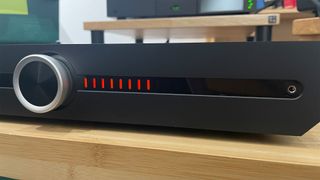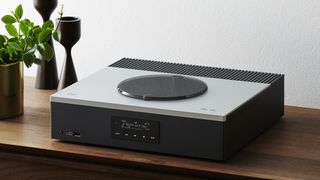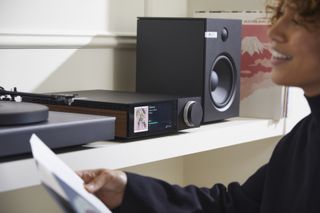Streaming amplifiers. Network amplifiers. Just-add-speaker systems. Whatever you prefer to call them, these one-box-streamer-and-amplifier components are one of the hottest trends in hi-fi now, with many of the established electronics brands having produced at least one over the past few years – Arcam, Cambridge Audio, Marantz, Naim and Technics, to name just a handful.
Their appeal is plain to see: why have two boxes of electronics – a standalone network streamer and standalone stereo amplifier – when you can have both functionalities in one? The only neater hi-fi system solution than having one box connected to a pair of speakers is an all-in-one speaker system whereby all the electronics are crammed into the speaker cabinets themselves.
Separates (i.e. multi-box) systems have their advantages over these more convenient two-in-one solutions (which we’ll get to later) in the pursuit of building the perfect hi-fi system, and that’s why their continuing existence is more than justified. But streaming amplifiers are getting better and better each year, and are understandably tempting for someone who values simplicity and neatness. So if you’re thinking about buying one, consider these pros and cons first...

I've been testing and writing about streaming amplifiers since they hit the market some years ago, and have seen their quality rise to the point where they are now much less of a compromised solution than they initially were. A network amp makes a lot of sense to a lot of people. Pairing separate, standalone stereo amplifiers and music streamers is still the 'purist' path for their superior performance and upgradeability, but streaming amps are convenient, space-efficient and take the chore out of system matching. Fantastic components in today's hi-fi world.
Streaming Amp Pros
Ultra convenient
Streaming amplifiers aren’t just convenient because they reduce system component count and take up less space than two boxes would. They also require fewer audio cables than a separates alternative. You can often connect all kinds of sources to a streaming amplifier – a turntable or CD player, for example – but thanks to their built-in access to streaming services, all you need to connect to a streaming amplifier is a pair of hi-fi speakers. And so all you need is one pair of speaker cables; not that interconnect between a streamer and an amplifier, not that second power cable that would require a second plug socket.
Also falling under this convenience umbrella is the need for just one remote, as opposed to potentially two (especially if the brands of a separate streamer and amplifier are different).

Negates (some) system matching
Choose a separate streamer and amplifier and you have to make sure they work together. Technically speaking they always will, but sonically the two components’ characters might not hit it off. Such system-matching considerations can make or break a system, so you don’t want to get it wrong. You don’t have to worry about such sonic synergy with streaming amplifiers, however, as the manufacturer has done that for you. The best streaming amplifiers feature components, from streaming chips to amplifier modules to power supplies, picked and implemented to work together optimally.
That said, you will still need to consider what speakers will work with your streaming amplifier. Generally, connecting kit with the same kind of sonic character together is usually a recipe for disaster, so it’s better to pair, say, a bright-sounding streaming amplifier with warmish speakers to get a more 'liveable-with' sonic balance.
Hi-fi sound
The best streaming amplifiers nowadays sound really quite good. There will always be a sonic compromise to many electronics internals sharing a compact space (we’ll get to that later), but generally the standard has really improved in the last couple of years, to the point that they can be at the heart of a formidable hi-fi system, with this awesome just-add-speakers streaming system being just one example worthy of highlighting.
We have awarded many streaming amplifiers five-star reviews, such as the Naim Uniti Atom, Technics SA-C600 and Cambridge Audio Evo 75 (pictured top), for their solid performances. That said...

Streaming Amp Cons
Comparatively compromised sound
Compared to the best standalone streamer and best standalone amplifier pairing you can buy for a combined price, the best streaming amplifier around that same price won’t match it for overall sound quality. Firstly, not all companies are as good at developing the streamer side as they are the amplification side, so there’s logic in two different components being better when made by two specialist companies in those respective fields. (You can read the pros and cons of building a single-brand hi-fi system here.) And secondly, as we mentioned above, sonic sacrifices are inevitable when components and circuitry for various applications share space inside a compact box with limited opportunity for isolation.
A decent streaming amplifier may well sound better than two average components connected together, but ultimately if you want the most sound quality possible for a particular budget, you're almost certainly better off going down the separates route.
Limited upgradability
The best thing about a separates system is that you can upgrade one component at a time, giving you the chance to tweak and improve bit by bit. The more boxes you have, the more control over your system (and its future) you have. So when two functions are combined in one box, as they are in streaming amplifiers, you have to replace both when the time comes to upgrade. Unless you, say, use the streaming amplifier’s streamer and preamp sections but connect it to a superior power amplifier in order to upgrade the amplification. But that’s not the most efficient way to system build, and that way you’re compromising the convenience you wanted in the first place.

So, should you buy a streaming amplifier?
So, is a streaming amplifier the best path for you to take? If you value neatness and convenience over outright sound quality and aren't overly concerned about a future upgrade path, a network amp is a hugely attractive option. We at What Hi-Fi? have tested many from the market's biggest players, and the appeal of having fewer cables, less rack space and a sonically matched, single-control integration is, in the best examples of the breed, as useful in practice as it is on paper.
Just note that you'll get the very best performance per pound (or dollar) if you go the separates route, which will also allow for easier step-by-step upgrades down the line. It's your call, and we hope you will now be in a better position to make it. If you've made your decision, check out either our best hi-fi systems buying guide for the best-performing streaming amplifiers, or our best stereo amplifiers and music streamers buying guides.
MORE:
3 key qualities that make a good reference hi-fi system
Why don't more young people have a hi-fi system?
When should you upgrade your hi-fi? How to control ‘upgradeitis’
